Arts, History and a very large Cemetary

AJAYA'S CRUISE
Phil & Nikki Hoskins
Mon 24 Aug 2009 00:47
|
Thursday 20th
We are walking miles each day to see as many of the
sites in Washington that are recommended viewing, and having survived the Air
and Space museum
we drew breath on the steps of the Smithsonian
Natural History Museum, put on the shoulder pads and shinguards and prepared to
do battle with the
Nation's children amongst the stuffed elephants,
lions and other exotic animals to see what we could learn in 2 - 3 hours which
we reckoned would be
about as much as we could survive.
  There are some fine exhibits on offer and in some
very life-like situations. The leopard with it's catch up a tree was a good
example. The Leopard looked
happy with his catch but has presumably been
waiting some years to be allowed to be seen
eating it. Fortunately the stuffed wildebeest exhibits were
spared the close attention of the nearby stuffed lions - a refreshing change from normal events
in the animal kingdom that we see on
television..
 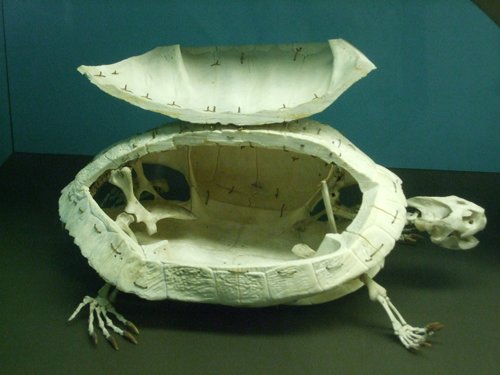 Moving onwards into the appropriately named 'bones'
section we spotted a tortoise with handy 'hinged shell for those
little items that tortoises need to
carry around with them'. Possibly where NASA got the idea
for the space shuttle loading bay doors from
and certainly a species that Darwin didn't get to see.
In the bird section Nikki overheard the
following - "awwwh Mom - no more dead birds pleeeeese!" to which the
reply was "They're not dead - they're
preserved !!!"
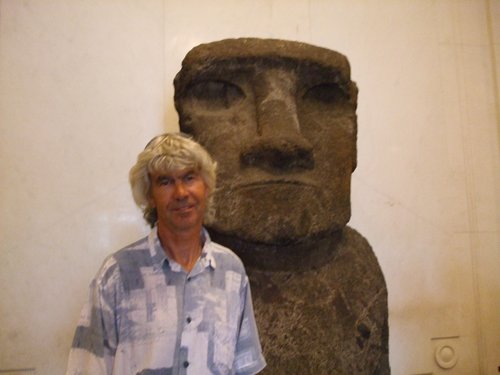 Nikki thought this Easter Island statue likeness
was uncanny. I thought it was unkind
Having survived the History Museum and lasted well
beyond our expected time it was off for some culture. The National
Gallery has some of the most valuable
paintings in the world from all the major artists.
It's huge and we knew we would be back the following day to finish off what we
couldn't manage this afternoon.
The Sculpture gardens are beautiful with giant
fountains criss-crossing the water to meet in the centre. In winter the pond is an ice-rink, difficult to imagine in
the heat and humidity currently on offer. The West Gallery houses all of the fine works from
1600s through to the modern 1950 ish era and was at one time the
largest marble building in the world.
 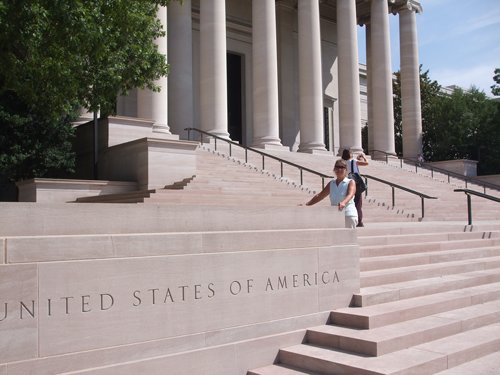    Purpose built, it really does show
off the works of art beautifully and, what was really surprising is that
the art was so accessible. No barriers and
very few restrictions on taking
photographs, albeit without flash. We were fortunate to see the original Monet
that we bought as a print from a Fareham
charity shop when furnishing our new
house back in 2000. Here it is below - the original that is! What a
coincidence......
 Friday 21st
Sure enough we didn't get round the West Wing that
day so it was back the next day to finish off and then visit the East Wing which
houses the modern artists
works.This building
was built later than the West Wing on land set aside for its purpose and
visually a very satisfying work of art in it's own right. The linking
subway with it's moving walkway and surrounding 42,000 Led lights which were computer
programmed to change intensity on a continual basis was in itself
considered one of the works of art on
display.
 This lead onto the main concourse which was on 3
levels
 However, much of the art in the building we
found challenging on the eye and so didn't dwell
so long in this part of the gallery. Although there was a separate
exhibition of Spanish still life and small French
post-impressionist paintings lent to the gallery by one of the benefactors.
Whilst not modern they were
a welcome exhibit
and a break from the blank or splattered canvases we had endured for an hour or
so. We still had time to take in one more museum
which was the National Museum of American History.
After the comparative tranquillity of the
Art galleries we entered the kingdom of chaos once more where
Phil had his feet trodden on a record number of
times in any one day. It wasn't helped by a thunderstorm which sent visitors to Washington scuttling to
the
nearest shelter which seemed to be this particular
museum. There were some interesting exhibits and
much information about the history of the USA
although some of this overlapped with the air and
space and American Indian museums that we had
already visited. For us it was perhaps the least enjoyable,
maybe due to the crowding and lack of space around
the exhibits. In truth it was sometimes hard to
see anything behind the throng let alone read anything
of value, so we exited for something more
interesting which is covered in the next
blog.
Saturday 22nd
We decided to leave Arlington Cemetery
until the weekend so as to get round the museums during weekdays when there
were less visitors. 'Ha'
The cemetery is served by a metro stop of the same name and a short walk from the station
brings the visitor centre into view where we collected a map of the
624 acres that are coveting the remains of over 320,000 American servicemen and
women. One of the first sites to be visited
is the tomb of JFK which has an
eternal flame burning amongst the slabs. Its position is dominant with views over Washington
that he would have appreciated whilst
looking straight up the hill
from the grave the former Arlington home of Robert E Lee can be seen.
  Most know the Kennedy story and within the
same grave lie the bodies of his wife Jackie Onassis Kennedy and two of their
virtually unknown children, a boy
and a girl who died shortly after their birth. A short distance away from the JFK grave Robert
Kennedy's simple headstone sits on its own. A very poignant
reminder
of just how much tragedy affected this generation
of Kennedys.
From here we walked up the hill to look at Robert E
Lee's former residence which was called Arlington before Arlington became a
cemetery. Robert E Lee
was a Virginian General in the US army who resigned
his commission in 1861 on grounds of loyalty to his home state when Virginia was
brought into the Civil war.
The Lee's moved out
of Arlington after having lived there for 30 years, leaving his slaves to
tend the estate and look after the family heirlooms.
Later the union army moved into
Arlington and the estate started to be used
to bury Union soldiers killed in the conflict which is when Arlington
began
to take on the appearance of a cemetery. After
signing the surrender of the confederates in the
presence of General E Grant, Robert E Lee never did return to
his home here but instead lived his remaining years
in Virginia. Arlington Cemetery has on average 30
funerals each day and has enough future capacity to last until
2060.
 The house itself is undergoing extensive renovation
to preserve it for future generations to see how an Army General from a wealthy
family lived just before the Civil
war.
Our next stop was at the tomb of the unknown
soldier of the civil war period, which isn't guarded 24 hours like the main tomb
dedicated to the unknown dead of the world
wars onwards. However, the changing of the guard
ceremony at the main tomb draws thousands each day who watch silently on the
half hour as a sergeant and 2
troopers carry out the change of
guard.
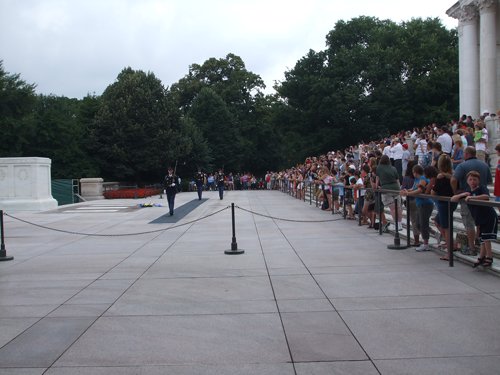 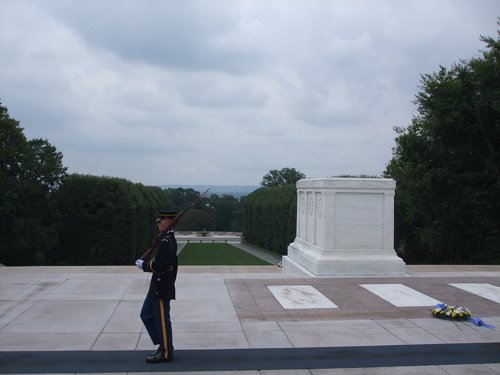  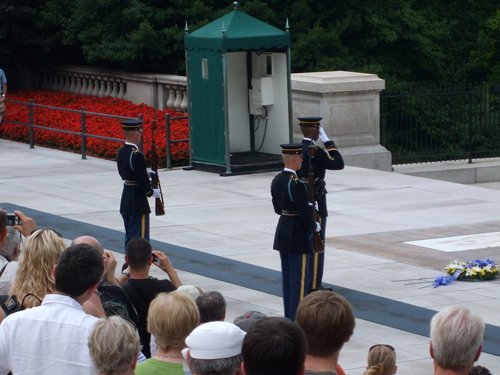 Having watched the change twice we wondered round
the back of the building to look at the large amphitheatre which is used for
ceremonies of re-dedication.
In recent years one of the bodies in the tomb was
re-interred elsewhere as his remains had by modern scientific DNA methods
been finally identified. So another
unknown body was then interned in the tomb to
represent the unknown fallen from that particular war. The ceiling at the
entrance was impressive we felt.
  It was at this point in our day that a storm system
enveloped the whole of Washington and surrounding districts and the rain
descended in torrents catching most
visitors out. There were some excellent candidates
for wet t-shirt competitions as the rain became relentless. Being extremely well
organised we dug out the
cagoules and made our way to the exit and back to
the metro stop for the trip back to the yacht club. This brought our planned
sight-seeing in Washington to
an end as we head back down the Potomac on
Monday.
|